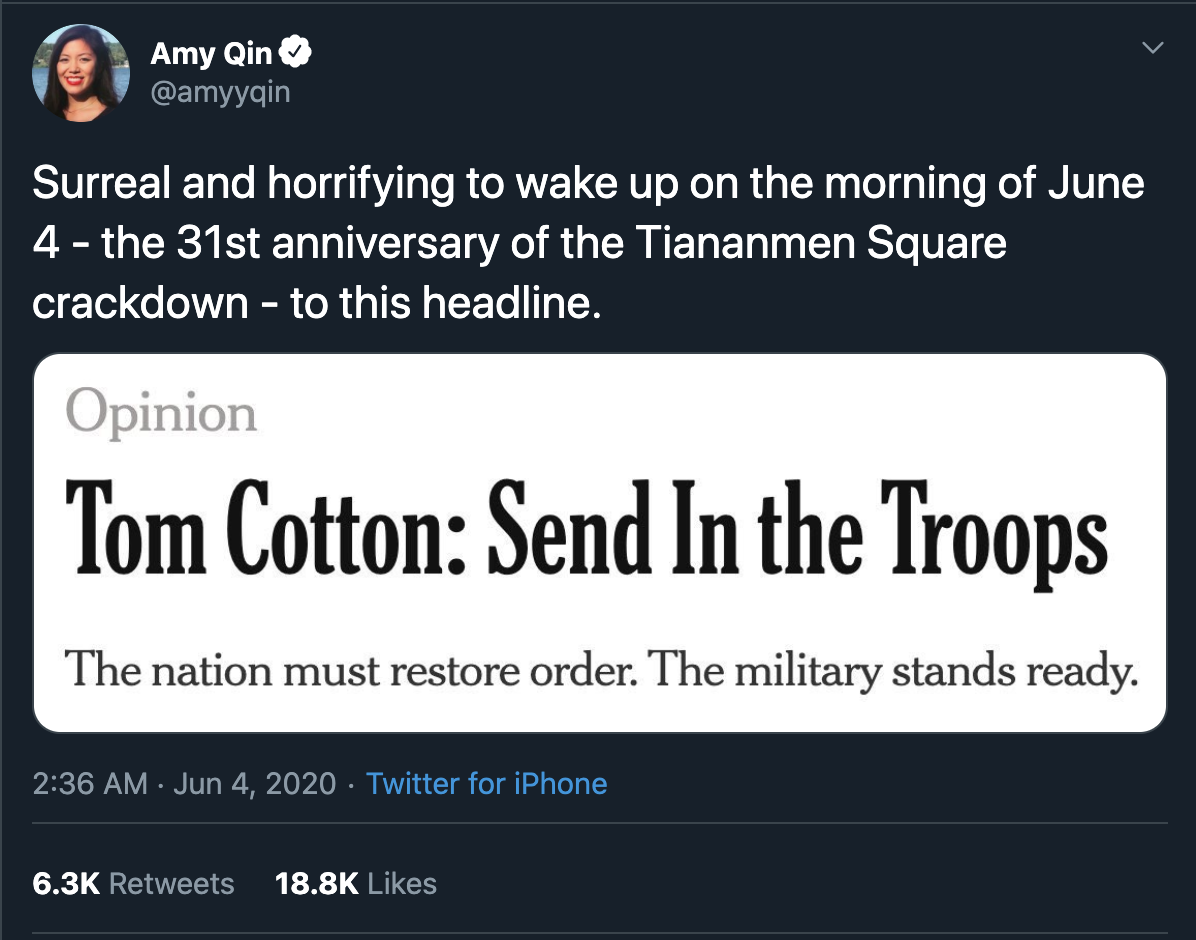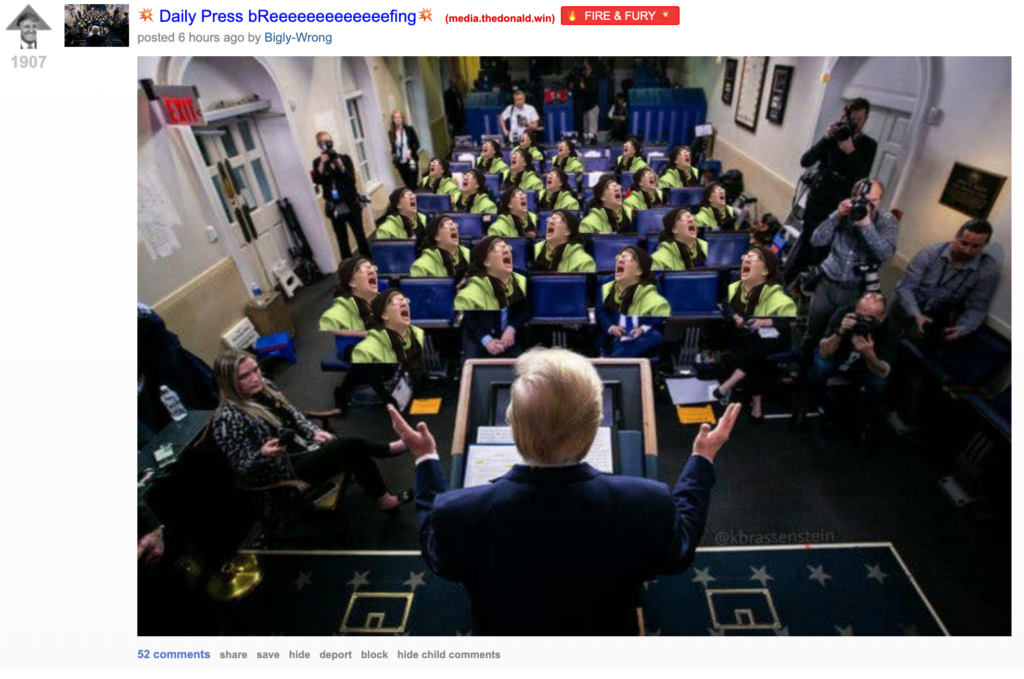Author: Dr. Simon Strick
August 2020
Facts and Bots

There was a tweet the other day. The author, New York Times tech writer Sarah Jeong, reacted with her message to the fascist iconography and instances of state-mandated violence against people and protestors that occurred in early June 2020 in response to the police murder of George Floyd. Playing on the internet genre of ‘hot takes,’ there was something of a heightened reality effect about this tweet: Twitter’s newly introduced service for better informational politics on the platform applied its ‘fact-checking’ label to the message: “(!) Get the facts about fascism,” the bot attached to Jeong’s tweet. Offering clickable “facts,” it followed the same algorithmic pattern that had enraged Donald Trump in the previous days and led him to propose legislation against Twitter’s fact-checking practice.
Twitter’s service proposes both a question and an answer: What are the facts about fascism? Click here. In this contemporary moment, characterized by “the rise of neofascism,” such factual Q&As are misleading and potentially harmful in digital public spheres: If anything, there is a dwindling corpus of qualifications that might elucidate what *fascism* is and how we can recognize utterances about *fascism* as true or false, facts or non-facts, sustainable or toxic (Schober), stabilizing knowledge or dissipating gossip (Horn).
In my work, I trace persons, movements, bots and platforms that – in various forms and disguises – dispute that “fascism is wrong and bad,” actually. If one was interested in speaking generally, the “badness” and “wrongness” of fascism would constitute disputed knowledges. In the current mediasphere, it seemingly falls to the bot (or social media platform) to try and remedy this crisis by offering up generality in the form of “facts about fascism.” The bot performs brute work – fact gathering –, a knowledge-labor to produce generality or consensus. “Fact-checking” negotiates and embodies fears revolving around the changing politics and practices of knowledge and the general itself. Paraphrasing Juliane Strätz, “the laboring body [or bot] reveals […] the precarious nature of what is oftentimes considered ‘normal’ or even ‘ideal'” (Strätz).
Offering up “facts about fascism” in this particular moment in history indeed reveals the precarity of knowledge in its digital condition. Fact-based argumentation seems futile (and robotic) in a situation where the president of the United States, orchestrated via social and legacy media, claims a position of global/personal persecution, designates Black Lives Matter protesters as “thugs” and “failed citizens” (Brückmann), and locks American cities down by aid of military and paramilitary domestic colonial forces. “Facts about fascism” seem to be doing no constructive work in what (in internet terms) is frequently labelled a ‘controversy,’ for instance surrounding the question whether fascism is, actually, wrong and bad. Neither would comparably ‘neutral’ knowledge-operations that could offer up things like this: “Get the facts about racism.” Who speaks, if we let the bots speak?
Surrealism 2020

There was another tweet: Amy Qin, China correspondent for the New York Times, reacted to an Op-Ed penned by Senator Tom Cotton (R-Arkansas), which the newspaper had decided to publish on June 4th, 2020. “Send in the Troops: The nation must restore order,” the Republican had headlined his call for national military action against the protesters assembling around #BLM. Qin responded to the article by invoking the memory of China’s Tiananmen-Massacre of June 4th, 1989. Qin pronounced the article as “surreal and horrifying.” Two observations follow from this juxtaposition – or collapse into each other – of transnational past and present violence.
A provisional thesis emerges from aligning 2020 with 1989: the United States (and the larger entity formerly known as ‘The West’) is currently and belatedly experiencing the end of the Cold War, thirty years after its former Eastern antagonists. The collapse of communism in the East – most pronounced in the former Soviet Union – was characterized by the dissolution of knowledge systems and organizational cohesion, resulting in a fracturing of state monopolies and the rise of private ones, the emergence of particularized nationalisms and ethnonationalisms (for example in Ex-Soviet states), and the destabilization of governing systems. The Eurocentric perspective discussed these developments, e.g. in the former Soviet Union, predominantly in the terminology of “failing states.” ‘The West’ – and the term’s implicit generality is becoming more difficult to commit to – currently experiences a similar transformation, a fundamental fracturing of the “rituals of consensus” (Bercovitch 1979) that had propped up the democratic-economic process through the second half of the 20th century: the democratic promise of participation seemed to override the racial, gendered, economic, and ableist disparities that colonialism and capitalism produce and exploit for profit, pleasure, and pain. This veneer has ceased to work: the fracturing of the US, which is also a failure of knowledge systems, occurs along the same systemic fault lines that American democracy pretended to successfully plaster over: racism, sexism, ableism, classism, and the colonial histories since 1619.
The second observation relates the media-induced dynamics which organize such failure of knowledge in this time of fracture. Qin’s reaction to the senatorial present of tanks and troops invokes the past in a characteristic gesture of contemporary digitized discourse, namely that of curation: In digitized knowledge economies, users and actors juggle and assemble diverse discourses, contexts, facts, and documents. Users are active as curators of disparate knowledges. A discursive characteristic of such memetic curation is that it aims not for the productionof knowledge, but rather for productive failures of knowledge.
As Amy Qin couples manifest and latent state-mandated military violence across histories, her curational act less induces the effect of (or argument for) “learning from historical violence,” but rather creates a particular affect, which we might call documentary surrealism (a sibling of Brecht’s defamiliarization): China’s repressive state-violence returns to haunt the US-American present. This curational, hauntological strategy calls up Genette’s narratological figure of metalepsis (Fludernik 2003), defined as the disorienting interruption of one level of narration (e.g. commemoration) into another (discussion of political proposals): metalepses are narrative short circuits causing a sudden collapse of the narrative system. Instead of accumulating knowledge items, the current mediasphere operates by such collapsing of competing frames of knowledge into each other, abstracting from their content (historical or political) and breaking referential frames.
It is beside the point whether Qin’s act – collapsing Beijing 1989 into Washington 2020 – are correct or adequate: curational operations are convincing, plausible or attractive, not because they offer more insight, neutral facts, or contexts. They attract and stick because they stage failures of knowledge as auratic, affective events, in which frameworks of knowledge – contexts or epistemologies – are tangibly plunged into crisis, producing a sense of surreality. The point of this curation, relating to my earlier thesis of a fundamental fracture within Western systems of knowledge, seems to be the production not of “facts about America 2020,” but of cognitive short circuits.
Short Circuits and Whiteness Wars
My current object of research, the neofascist Alternative Right in the US and Europe, has gained considerable traction in the last 15 years mainly because its actors and agents have pioneered and refined such digital/curational tactics for their agitational and ethnonationalist purposes. They have done so on the internet, in party politics, in public discourse, popular culture, and in academia. This meme, from early May 2020, originates not from Twitter, but from one of their larger forums of cultural warfare, the website TheDonald.win.
The image also stages an encounter of disparate elements, a metalepsis: Donald Trump’s press briefing is, by way of Photoshop, filled with images of the famous “screaming woman” of 2016, one of the iconic reaction images to his election. To the Alt-Right, the meme’s point is simple: everything the President says will make the “liberal mind/the media” scream out. They think this is good and funny, and it is true to a certain extent: many, myself included (Strick 2019), have written repeatedly on the sensation of cognitive exhaustion when listening to Trump, the media systems his followers inhabit, let alone this administration’s and electorate’s actions. If one interlocutor in a communication system (the US) forces the other one to scream, we might contend that this system is broken.
The meme stages such effective failure of discursive communality as antagonism between two white bodies, in order to claim victory in the ongoing culture war: “We will make you scream (and there is nothing you can do about it)”. The meme does agitational and propagandistic work in that it bestows an auratic quality on this failure of white communication. Such iconizations – staging spectacular failures of white communality – have become reality not only in heads ringing from cognitive dissonance, but their repercussions are imprinted materially and violently on People of Color.
Consider this recent scene: when Trump warned of a “new far-left fascism” (Remarks by President Trump at South Dakota’s 2020 Mount Rushmore Fireworks Celebration) at Mount Rushmore on July 3rd 2020, Native American activists demonstrated against such messaging on Native American land, with signs reading “You Are On Stolen Land”. (Native Americans protest Trump’s Mt. Rushmore rally). Police detained 21 protestors, reportedly over Trump-supporters shouting “Go back home” at the activists. While Trump claimed that “This monument will never be desecrated,” Harold Frazier, chairman of the Cheyenne River Sioux Tribe, told the press that “The president is putting our tribal members at risk to stage a photo op at one of our most sacred sites.” (BBC.com)
This scene highlights that the above-mentioned meme – iconizing a “broken America” – presents the faultlines of this knowledge crisis through the exclusion of Black, Indigenous, and People of Color. The Alternative Right – now grown into a densely populated, diverse, presidential, and highly impactful counterpublic – succeeds with its ethnonationalist, misogynistic, and racist strategies largely because it offers up the current moment as a conflict between (highly gendered) versions of whiteness: liberal vs. republican, “feminist” vs. “alpha-male,” “cucked” vs. “patriot,” “snowflake” vs. “rational,” if you happen to be interested in their vocabularies. Juxtaposing such varieties of “whiteness enfleshed” (Berlant) is the chief tactic of neofascism and right-wing populism to shrink the political horizon and reduce possibilities for critique, resistance, and alternative knowledges.
To undo such whiteness wars, in my opinion, is a chief task for American Studies. The critical projects found in our network – investigating the failures of knowledge and knowledges of failure for the next three years – inspire such necessary undoings by focussing on much-needed questions of epistemology, and the racialized and gendered politics of knowing and failing. They are vitally important to the discipline of American Studies.
——————
Bercovitch, Sacvan. “The Ritual of American Consensus.” Canadian Review of American Studies 10.3 (1979): 271-288.
Fludernik, Monika. “Scene shift, metalepsis, and the metaleptic mode.” Style 37.4 (2003): 382-400.
Strick, Simon. «TIRED TRUMP, oder die Ermüdung der Theorie», in: The Great Disruptor. Über Trump, die Medien und die Politik der Herabsetzung. Eds.Lars Koch, Tobias Nanz, Christina Rogers. Stuttgart: Metzler 2019. 27-46.

